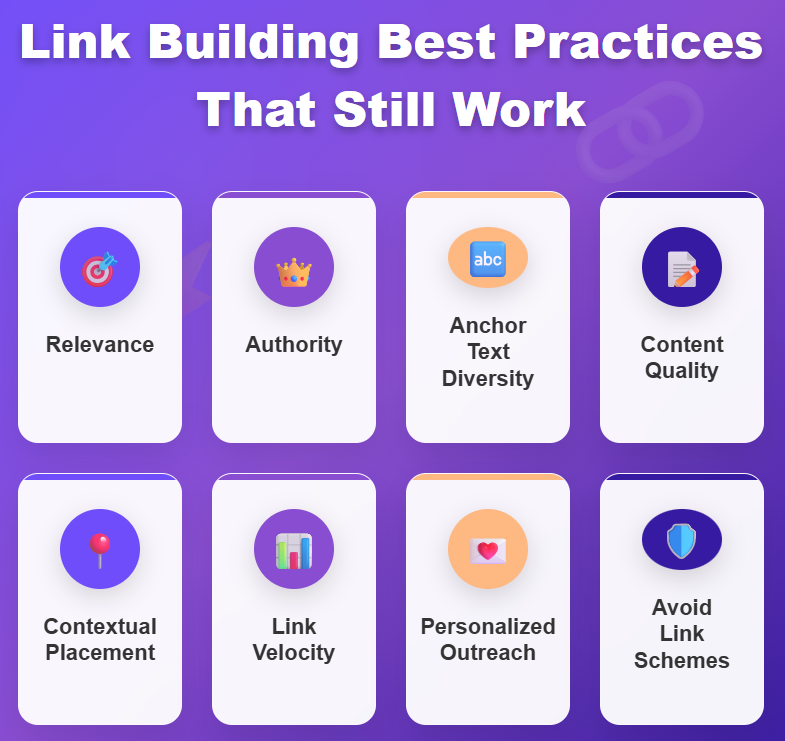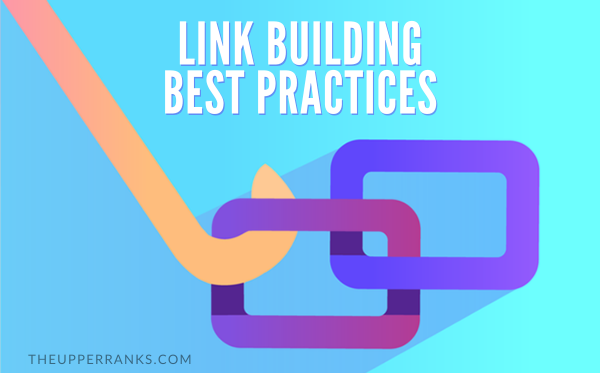- Link Building Best Practices That Still Work
- Modern Link Building Pitfalls to Avoid
- Why UX Is No Longer Optional for Link Builders
- Understanding Google’s Page Experience Signals
- Link Building and User Experience
- How Bad UX Wrecks Your Link Building Efforts
- Practical Tips for Better Link Building
- So, You’re Saying I Have to Be a UX Expert?
- Closing Thoughts
Link building isn’t just about authority and anchor text anymore.
Sure, you still need relevant placements, natural anchors, a clean link profile, and strong content. Those are the basics.
They’re the classic link building best practices that still matter, even as the algorithm evolves.
But here’s the problem. Most people stop there.
If you want your links to actually work to improve rankings, drive real traffic, and build trust – you need to think beyond the link itself.
You need to consider what happens after the click.
Think before you link.

We’ve all followed links that led to slow pages, confusing layouts, or sites that don’t work on mobile.
It’s frustrating. It kills trust. The user bounces, the site that linked to you looks bad, and your brand takes the hit.
That kind of UX ruins links, even if they look great on paper.
Good link building isn’t just about pleasing Google. It’s about serving the user.
And in today’s SEO landscape, your links need to lead somewhere fast, helpful, mobile-friendly, and trustworthy.
Otherwise, you’re just creating noise.
Link Building Best Practices That Still Work
Before we dive deeper into UX and Page Experience, let’s cover the foundational link building best practices that still matter, and probably always will.
These are the tactics that stand the test of time, and while they aren’t flashy, they’re what separates a healthy link profile from one that tanks.

Relevance – Relevance is king in the link building world. If you’re in the finance space, a backlink from a pet grooming blog won’t move the needle, and could actually raise red flags. Google wants links that make sense in context. That means building relationships with sites in your industry or related verticals, and placing links where users genuinely benefit from them. Relevance is what makes a link feel natural.
Authority – Yes, domain authority (or DR if you use Ahrefs) still matters. A link from a trusted, established site will always carry more weight than a fly-by-night blog. But don’t chase high DR blindly, sometimes a lower-DR site in your niche is more valuable than a general news site with no topical connection. Vet domains based on real traffic, organic visibility, and editorial standards.
Anchor Text Diversity – Using the same anchor text over and over? That’s a shortcut to an unnatural link profile. Instead, mix it up: branded anchors, partial match, generic phrases like “this post,” even raw URLs if it makes sense. Natural variation is key. Google’s looking for signs that your links were added for humans, not for bots.
Content Quality Around the Link – A link is only as good as the content it’s sitting in. Thin, poorly written articles or content packed with irrelevant outbound links can drag down the value of your placement. Aim for contextually relevant, well-written content that actually gets read. Better yet, write it yourself and make sure it delivers value beyond just housing your link.
Contextual Placement – Links work best when they live inside relevant paragraphs , not in sidebars, footers, or author bios. The surrounding content helps Google understand what the link is about and how it should pass value. If your link is buried at the bottom of a 1,500-word article no one scrolls to, don’t expect much return.
Link Velocity – Earning links too fast can trigger spam signals, especially for newer sites. Instead, aim for a natural-looking growth curve. A handful of solid links every month will serve you better than a sudden spike followed by radio silence. Google rewards consistency more than chaos..
Outreach Personalization – Blasting out generic templates doesn’t cut it anymore. Editors can spot AI-spam from a mile away. Take the time to read the site you’re pitching, reference actual posts, and explain why your content adds value. A thoughtful pitch has a much higher chance of getting accepted — and building real relationships.
Avoid Link Schemes – Google’s still watching. Link swaps, PBNs, and buying placements on sites known for selling links can do more harm than good. One or two risky links won’t kill you, but a pattern will. Keep it clean and focus on long-term sustainability.
Modern Link Building Pitfalls to Avoid
Even with all the tools, guides, and checklists out there, it’s still easy to mess up link building.
Especially now, when Google’s quality filters are tighter than ever.
Here are some of the most common link building pitfalls I see people still fall into.
Irrelevant placements – Getting a link on a high-DR site sounds great — until you realize the topic has nothing to do with your niche. Relevance matters more than raw metrics. If the site’s audience would never care about your content, that link isn’t helping.
Over-optimized anchor text – If all your links say exactly what you’re trying to rank for, that’s a problem. Google’s seen that game before. Mix it up with branded, generic, and natural anchors to keep your profile clean.
Low-quality content farms – Some sites exist just to sell links. The content is generic, usually AI-written, and published at unnatural volume. If a site’s only real purpose is to trade backlinks, you don’t want to be part of it.
Forcing product or category pages into editorial content – Yes, you want links to your money pages. But forcing them into blog posts where they don’t belong makes your whole strategy look spammy. If it doesn’t serve the reader, it’s not a smart link.
Ignoring mobile performance – You built the perfect link… and the landing page breaks on mobile. That’s a fast way to kill credibility and rankings. Mobile-first isn’t optional anymore — it’s the baseline.
Not verifying links after they go live – You did the outreach, they added your link… but it’s buried in the footer, surrounded by spam, or no-followed without notice. Always double-check. A bad link can do more harm than good.
Why UX Is No Longer Optional for Link Builders
So, how will Google’s focus on user-centric metrics like Page Experience affect your approach to building links?
It’s something I’ve been thinking about lately. My thoughts led me to this scenario: When was the last time you were frustrated by a poorly optimized website?
Don’t deny it—it happens to everyone who browses the web on a desktop, phone, or tablet. You tap on a link, maybe from a social media post, and arrive on a site that’s impossible to navigate. It’s littered with poorly-timed popups, “continue reading” buttons, and autoplay videos.
Browsing those sites is an exercise in annoyance.

But there’s something even worse. Have you ever been reading something on a site you trust, one that offers a carefree browsing experience, and tapped a link that ruins the whole venture?
One moment, you’re on a site you love, and the next moment you’re on a site that isn’t even mobile-friendly.
If you’ve had that experience and got burned once, you’re far less likely to follow a link from that site again.
And I trust you’ve seen the comments, too.
Popular ones include:
“That site is like a parasite on my computer.”
“I’m on my phone, and that link is unreadable.”
“Why link to something I can’t even read on my phone? It’s 2025!”
No one wants those comments on their website or social media profiles. And no one wants to follow those kinds of links.
Now, think about who’s behind the worst possible examples of link placement on the internet—the people who have no regard for anything but their link.
Link builders. Yeah, you guessed it!
Now, of course, I’m not talking about you or me. If you’re reading this article, you’re likely a link builder who puts in the effort to create good links that enhance the user experience.
But not everyone understands the intersection between UX and link building.
Many people want to take the easiest, cheapest route possible—future consequences be damned.
We don’t know everything about how Google’s Page Experience algorithm affects your SEO rankings. Google’s very good at keeping secrets, after all.
But, I think it will help every link builder to be a little more mindful of the overall user experience on their sites.
The sky isn’t falling, but we might as well keep an eye on the weather.
Understanding Google’s Page Experience Signals
Before we dive into how this affects link builders, it’s important to take a closer look at what we know about Google’s Page Experience algo and its emphasis on Core Web Vitals.

Google has continually emphasized the importance of user experience, and this focus has evolved significantly since the days of mobile-first indexing. Today, Google’s Page Experience algo plays a key role in shaping rankings, highlighting metrics like Core Web Vitals alongside factors such as mobile usability, HTTPS security, and the absence of intrusive interstitials.
From Google:
“A good page experience doesn’t override having great, relevant content. However, in cases where there are many pages that may be similar in relevance, page experience can be much more important for visibility in Search.”
This reflects how most Google searches now take place on mobile devices. Google’s ranking systems evaluate user interactions, ensuring a seamless experience across both desktop and mobile devices.
Key factors Google considers:
- Core Web Vitals: Metrics like loading speed (Largest Contentful Paint), interactivity (e.g., Interaction to Next Paint), and visual stability (Cumulative Layout Shift).
- Mobile Usability: Ensuring a site’s design and navigation work well across mobile devices.
- Content Consistency: Making sure content is equally accessible and engaging on both mobile and desktop versions of a site.
This shift toward prioritizing user experience has transformed how websites are evaluated, making it critical for webmasters to optimize for speed, responsiveness, and usability across all devices.
As mobile continues to dominate how people interact with the web, ensuring a seamless experience on these devices is no longer optional—it’s a necessity. Poor usability, inconsistent content, or intrusive popups can cost websites both users and rankings.
By aligning with these principles, Google aims to make browsing the web on any device more enjoyable and frustration-free.
Link Building and User Experience
Google is always on the minds of SEOs and link builders and it’s important for us to realize how serious Google is taking UX into consideration when ranking pages.
Part of Google’s philosophy has always been focused on delivering the best user experience. With recent technological advances, Google and other search engines are now better placed than ever to deliver this vision. This focus will only intensify over the coming months and years.
Yet for many teams and agencies, UX has not consistently been a part of the SEO toolkit. Whether or not an SEO practitioner can discuss UX or make meaningful UX recommendations very much depends on personal experience, background and professional development programs.
UX is often the last thing on the minds of link builders. We’re busy thinking about search engine visibility, linkable assets, and how to improve our outreach efforts.
But even when we’re not considering UX, Google definitely is.
Google’s goal with the SERPs is to serve up the best possible search results for any given query.
Since Allstate ranks number one for ‘car insurance,’ you’d best bet their website is user-friendly and that you’ll land on a helpful page when you click the link from the SERPs.
Car insurance is a highly competitive field, so it makes sense that Google factors UX into its ranking algorithms, along with content, links, and a few other factors.
In that regard, I don’t believe a low quality, thin content, non-navigable page with 100,000 links could ever outrank Allstate– at least not in the long term.
Google doesn’t want to lose its seat as the world’s number one search engine, so they’re dedicated to serving up good search results. Good search results mean good webpages– webpages the user can easily navigate on desktop and mobile, while finding the information they need.
Quality, relevant links will help catapult your website into better search engine visibility but, going forward, I really don’t think you’ll be able to compete if you’re not thinking about how the user will feel when he reaches the other end of the link.
How Bad UX Wrecks Your Link Building Efforts
Bad UX is all around us.
In the name of better search rankings, there are those that will do almost anything, as long as it doesn’t technically violate Google’s link schemes guidelines.
This makes for a much worse user experience and, quite honestly, pollutes the web.
There are a number of red flags when it comes to links and the user:
- Links that take you to unhelpful ‘money’ pages, such as product or category pages.
- Links that take you to websites that are impossible to navigate.
- Links that take you to tabbed content, in which the information they sought is hidden within a tab.
- Links that take you to infinite scroll pages, in which multiple subtopics reside on a single URL, with no method to land the consumer on the section relevant to their search.
Let’s take the infinite scroll example first.
Say you built a link to your tax software website with the anchor text “tax exemptions for single parents.” The link leads to the “tax preparation” category on your blog, which is an infinite scroll page.
You want a link to that category on your blog so you can rank higher for either “tax preparation” or “tax exemptions for single parents”.
But when the user has to scroll down four or five pages before they find anything related to tax exemptions for single parents, they’re going to give up and close the tab before they find the information they need.
They’re going to feel far less trusting of both you and the site who hosted you link, and they’re going to run right into your competitor’s arms.
If you’re using the anchor text “tax exemptions for single parents,” you’d better be pointing that link to a page that clearly explains what these tax exemptions are, without sending the user on a fishing expedition.
Let’s look at another example. Say you got someone to link to one of your product pages. They use the anchor text “I recently bought this organic cat food,” and it links to one of your product pages for said cat food.
But when the user lands on your page from their iPhone, it’s a garbled mess.
Images are broken, and they have to zoom in and scroll around to find the ‘buy now’ button. The font is too small for them to read about the cat food itself, and the checkout process is counter-intuitive. That’s because you never tested your product page for mobile devices.
If a user has difficulty, you can rest assured Google will notice.
Google doesn’t like ranking pages that don’t serve mobile users– so how much good did that link actually help you, in the end? Not very much.
Practical Tips for Better Link Building
Want to avoid wasting time on links that don’t help?
Here are a few things to focus on if you want your links to actually move the needle, without annoying users or hurting your site in the long run.
- Evaluate Sites Before Outreach – Target sites that are fast-loading, mobile-friendly, and free of intrusive elements like popups or autoplay videos. Test the site on a mobile device to ensure it offers a smooth browsing experience and aligns with Google’s Page Experience standards.
- Prioritize Relevant and High-Quality Sites – Look for sites with strong content and an engaged audience that aligns with your niche. The value of a link increases when it’s placed on a site with authority and relevance to your target audience.
- Build Links That Add Value – Focus on securing placements where your link naturally enhances the content and provides value to readers. Avoid overly promotional or forced placements, which can harm credibility and rankings.
- Diversify Your Link Profile – Don’t rely solely on one type of link (e.g., guest posts). Leverage various strategies like resource link building, content collaborations, and participating in niche directories to create a well-rounded link profile.
- Verify Links After Placement – After securing a link, ensure it is functional and accessible, and that the placement isn’t buried in content or surrounded by spammy links.
- Foster Long-Term Relationships – Develop connections with webmasters and content creators in your industry. Building rapport increases the likelihood of future collaborations and ongoing link opportunities.
So, You’re Saying I Have to Be a UX Expert?
I’m actually not saying you have to be a UX expert at all!
What I’m saying is that you should always keep the users in mind when building links. Even putting Google aside, UX is important when it comes to links.
You build links to increase search engine visibility and boost web traffic– but you also want the user to convert and buy something as well.
If the user has a poor experience, they’re far less likely to buy anything once they land on your page from a link, or from the SERPs. UX serves to encourage “good user behavior.” Basically, when a website performs well in the search engines, and also creates an intuitive experience for the user (which inspires that good user behavior), you have the best of both worlds.
Influencing good user behavior will lead to metrics like longer times on site, lower bounce rates, more pages per visit, and higher returning visitor counts. While the goal of [SEO] work is to attract visitors, the goal of [UX] work is to nurture visitors and turn those visits into conversions.
The function of UX in SEO begins with user friendly web design. Usability and simplicity are typically the primary goals in UX driven web design…
User-friendly web design includes:
- Using logical page layouts.
- Prominently featuring important elements like contact forms and and links to primary pages.
- Employing fast load speeds.
- Using CTAs and callout sections to drive traffic to your conversion pages.
- Ensuring a good experience on all devices and browsers.
A user’s time spent on your site, and their bounce rate, can also affect your search engine visibility.
Basically, first impressions are everything, once someone lands on your site. If the user can’t figure out what’s going on with your website shortly after they land there from a link or from the SERPs, they’re going to abandon ship.
Speed is also super important and most visitors will abandon a slow site within three seconds.
Closing Thoughts
There’s no silver bullet in link building.
What works best is doing the simple things right, and doing them consistently.
The link building best practices that have stood the test of time are still your foundation.
That means earning links from relevant, trustworthy sites.
Using natural anchors. Writing content people actually want to link to.
Sending outreach emails that don’t sound like spam.
These are the basics that keep your strategy solid and your backlink profile clean.
All the fundamentals we’ve known for years still matter.
But SEO isn’t standing still.
If you want your links to last, to actually help your rankings and brand, you also need to care about where those links lead.
A link that brings someone to a slow, messy page isn’t doing you any favors.
Good link building isn’t just about the click. It’s about what happens after.
So yes, follow the best practices. Keep things clean. Build relationships. Stay relevant.
But also take that extra step: test your links, review the pages, and make sure you’re sending users somewhere that actually works.
Because in today’s SEO landscape, the best links don’t just check a box, they build trust, drive real traffic, and support long-term growth.
That’s what sustainable link building looks like.





Comments
Great article! Posted it on my LinkedIn. Thanks for the info.
Thank you, Maria!
Very useful information thank you for sharing.
Glad you enjoyed and found it useful!
Read this entire post from beginning to end – that’s very rare – super summary of mobile indexing!
Ha, thanks Ron!!
Great article, very useful information about how Google’s mobile-first index works.